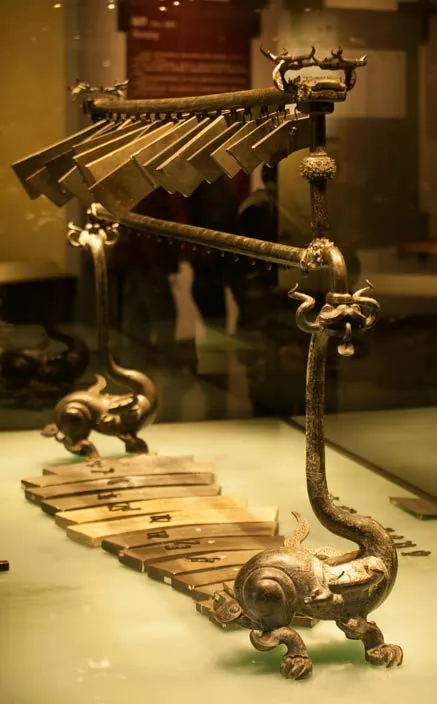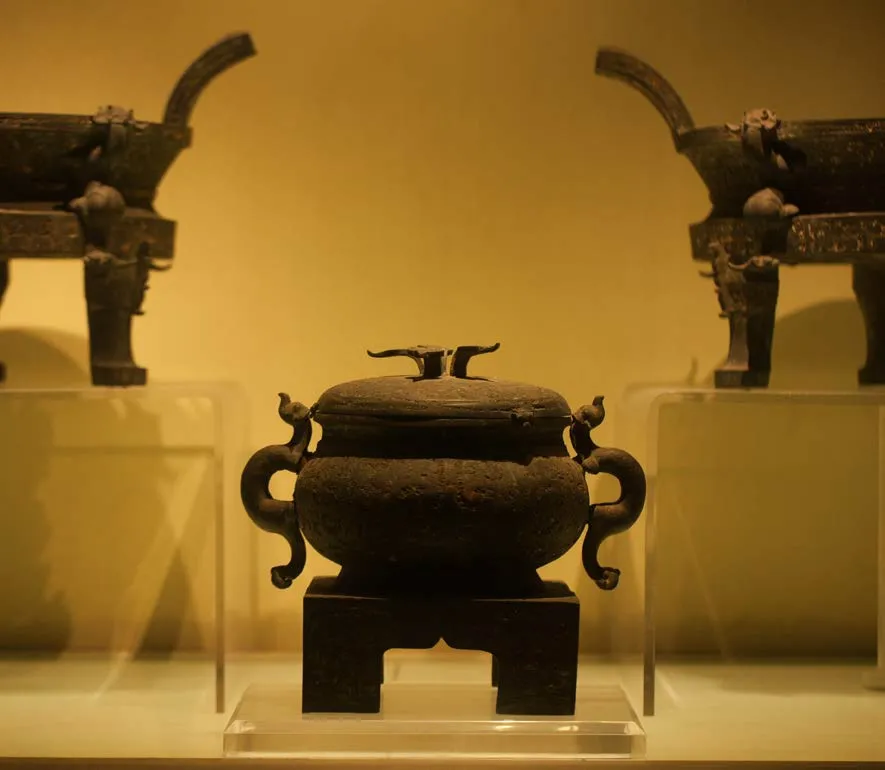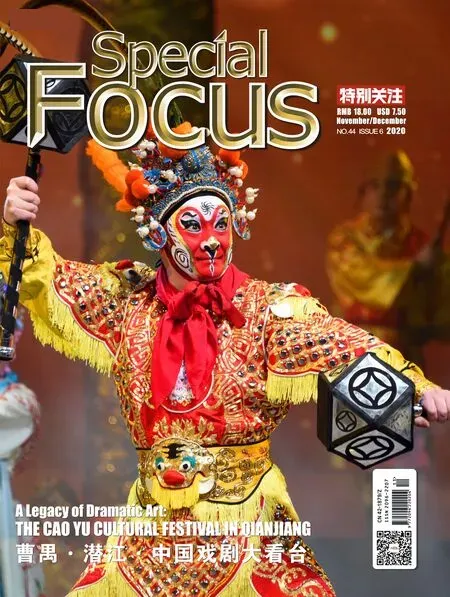Excavation of the Chime-bells
2021-01-09TextbyLiuYishan
Text by Liu Yishan
Edited by He Sai, Bai Ning & Liu Kezheng
Photos by Su Zhuolin
The tomb consists mainly of four chambers. The previous story had a detailed description of the eastern, western, and northern chambers; this story will focus on the middle chamber—the largest of all, covering a total area of 46.3 square meters. This chamber stored the largest number of articles and items, among which the chimebells were the most magnificent and most spectacular.
The grand chime-bells, listed as a rare national treasure and the majestic king of Chinese music, was saturated with the Chinese civilization and wisdom. These bells are the living fossil of ancient science and technology, as well as the historical record of social development of ancient China. They were buried underground silently until excavated on May 22, 1978.
Treasures in the central chamber
On the east side of the central chamber sat a bronze drum base with a jiangu drum on it. To the north of the jiangu drum and close to the eastern wall, there is a pair of large bronze pots that stand parallel on a single stand. The uniqueness of the twin pots lies not only in the fact that they have lids, but also a hollowed hood (similar to a hollowed circular ring) around the mouth. This feature has a decorative effect, making them look more solemn and sacred, while the hollow hood made the lids better fit the mouth, which seemed stable and immovable.
North to the twin pots was a pair of grand jian and fou, which consisted of two utensils: a square jian exterior and a square fou interior. Jian was originally designed as a big basin to hold water. It was recorded in Zhuangzi’s article “Zeyang” over 2400 years ago that, “Duke Ling of Wei has three wives, once all of them bathe in the same jian together.” One basin could hold three women, you can imagine how big it was. Ancient rice wine went sour easily, hence ice was stored between walls of jian and fou in winter to preserve rice wine fresh. They were the most advanced ancient freezers. Both jian and fou had been unearthed earlier in other places separately. This discovery made people aware of the fact that they were used as a complete set.
To the west of the grand jian and fou was an extraordinarily fine, exquisite, and ingenious set of bronze zun and pan (its matching tray). Their molding method, the so-called de-waxing molding process, has not been deciphered up until today even after many efforts by archaeologists. Liu Xinglong, a notable contemporary writer, exclaimed the elegance of the zun and pan of Marquis Yi of Zeng and the greatness of their foundry craftsmanship in his novelP an Hui (coiled snakes, a pattern unique to the zun and pan excavated from the tomb of Marquis Yi of Zeng), indicating that no comparable technique could be found in any other part of the world.

Bronze base of the jiangu drum 鼓铜座
伟大的编钟,这个有生命有灵魂的庞大音乐之王,凝注了古代中国文明、智慧、科技水平以及历史记载的超级国宝,在茫茫的黑暗中等待,一直等到 1978年5月22日。
中室宝器
中室的东壁,放置青铜鼓座并有建鼓一件,建鼓原来放于鼓座之上,竖立着。
在建鼓之北,紧靠中室东壁有一对青铜联禁大壶,即两件大壶同置于一个禁座上。
这两件大壶有一点比较特别,它们除有盖外,盖沿外还有一个镂孔盖罩(近似于一个镂孔大圆环)。盖罩一方面有着装饰作用,使壶显得更庄重,更有气势;另一方面,安上盖罩使壶盖扣合更稳固而不致挪动。
紧靠联禁大壶,其北有一对大鉴缶。鉴缶是由两种器物组成,外为方鉴,内置方缶。
鉴的本意是装水旳大盆。《庄子·则阳篇》中写到:“灵公有妻三人,同鉴而浴。”一个盆可容三人洗澡,可见其大了。
古代的米酒容易变质,每年冬天将冰贮存起来,放置鉴内,将方缶内的酒冰镇起来,使之不易变质,这是古人用的冰箱。
鉴和缶两器过去也出土过,却是分开出土的,并不知它们是放在一起配套使用的,直至这次一起出土,才真正弄明白了它们的用途。
大鉴缶的西部,还放置着一件极其精美精致精巧的青铜尊盘,这尊盘的铸造之法,即失蜡法,考古人员费了许多功夫,目前尚未破解。当代著名作家刘醒龙在长篇小说《蟠虺》中,写尽了曾侯乙尊盘的精美和其铸造工艺的伟大,在世界上找不出与之相匹的技术。

Bianqing, a percussion instrument编磬,打击乐器
The bianqing (stone chimes) was found in the northern part of the central chamber. On the bases of the bianqing stood two fantastic bronze-cast beasts facing the same way. Each of them was molded with the head of a dragon, the neck of a crane and the body of a tortoise. They support two layers of the chimes, both upper and lower layer arrayed 16 pieces each—all of which had been cleared out from the sludge at the bottom of the tomb.
Apart from the chimebells, bianqing, jiangu drums, and jian and fou sets, other unearthed objects in the central chamber included 7 ses (a plucked instrument similar to a zither), 5 shengs (reed pipe wind instrument), 2 panpipes, 2 ruos (shaped like a bamboo flute), 2 small drums, some lacquered cups and the like.
In the southern part of the chamber, groups and rows of bronze sacrificial vessels were found. The top of the 9 dings (an ancient cooking vessel with two loop handles and three or four legs) was covered with bambooweaved lids, and on each of the bodies of 5 dings was a pair of hooks. Right in the middle stood two huge dings and in each of their handles hung a hook, upside down. A long-handled bronze spoon draped horizontally across the rims of the two dings, indicating that it was applied in conjunction with the dings.
9 dings were placed at the forefront and 8 guis (a widemouthed container for food) came behind. The set of nine dings and eight guis represented the social status of the owner. According to the rituals of the Zhou Dynasty, only the emperor could use them together.
Besides, there was a great variety of other utensils like pans, braziers, sifting shovels, huo dings (a vessel for boiling the meat in major ceremonies), round jians, all of which were arranged in very good order, obviously absent from the impact of mud or flowing water.
Some beef bones were found in two huo dings. In the other dings, beef, pork and fish bones were left, while wild goose bones were discovered, too.

Se with colored lacquer 彩漆瑟
中室的北部,出土有编磬。
编磬架座由一对青铜铸造的怪兽组成,怪兽由龙头、鹤颈、龟身糅合为一体,奇特而别致。磬分上下两层悬挂,每层16 块,共32 块。这些磬块都是从墓底淤泥中清理出来的。
编钟、编磬、建鼓及鉴缶等摆放的中室之间,还出土了瑟7件,笙5 件,排箫2 件,箬(形似竹笛)2 件,小鼓2 件,还有一些漆杯等。
中室的南半部,青铜礼器成组成排,9 件升鼎上,各用竹编制的盖子盖着,5 件鼎上,各有一对鼎勾,正当中有一对大鼎,鼎耳上各倒挂一个鼎勾。一件长柄青铜勺,置于两件鼎的口沿上,表明是与鼎配套使用的。
9 件鼎摆在最前面,8 件簋居其次。“九鼎八簋”是显示墓主身份的,按周礼,只有天子才能用。
此外,还有盘、炭盆、漏勺、镬鼎、圆鉴等各种器物,林林总总。这些器物整整齐齐排列,没有受到泥土和流水的冲击。
两件镬鼎内,各有半边牛骨骼,其他鼎器内还有牛、猪、鱼和雁的骨骼。
中室其他的器物不再一一细说。总体上看,中室北半部,置放了编钟、建鼓、编磬、瑟、笙、排箫等乐器,这里是曾侯乙的音乐厅无疑。南半部摆的是礼器和洗漱具、煮肉之鼎,加上冰酒用的鉴缶配套,这里是曾侯乙盥洗、吃肉、喝酒的地方。曾侯乙听着编钟、编磬演奏出的金声玉振之音,吃着肉喝着酒,身边还有美女伺候,在地宫里依旧生活享乐。
All in all, the northern section of the central chamber was set with musical instruments, such as the chime bells, jiangu drum, stone chimes, ses, shengs, and panpipes. Doubtlessly this was the odeon of Marquis Yi. In the southern part were the ritual and sacrificial vessels, toiletries, dings for cooking meat, together with the jian and fou. It was the place where Marquis Yi washed, ate, and drank, where he still enjoyed himself in this underground palace while being served by beautiful maids, listening to the euphonious music, devouring his meat and savoring his wine.
The grand chime-bells, listed as a rare national treasure and the majestic king of Chinese music, was saturated with the Chinese civilization and wisdom. These bells are the living fossil of ancient science and technology, as well as the historical record of the social development of ancient China. They were buried underground silently until excavated on May 22, 1978.

Gui, a sacrificial vessel used to hold staple food簋,供奉食粮的祭器
The chime-bells unearthed
As the water gradually drained, it was daybreak and the red morning sun rose in the east. After waiting for over 2,400 years underground, the chime bells of Marquis Yi of Zeng saw their first ray of sunshine.
Amidst the shouts of the cheering crowd, Tan Weisi calmed down while checking the water condition. He instructed the workers to slow down the pumping lest the chime bells should collapse and suffer irretrievable damage because of loss of buoyancy due to the water recession. The chamber containing the outer coffin was 3.3 meters deep, and the emerged part of the wooden beams was barely one meter above water and more than two meters of their bodies were still soaked in the water.
Tan Weisi and his workmates formulated a “two-preventionone-guarantee” plan quickly. Firstly, prevention of sun exposure: getting steel frames and plastic roof to shield the relics from sunlight. Secondly, prevention against collapse: installing safety racks on the tops of the walls, from which broad bands of the folded plastic membrane could be stretched down to hold the beams and prevent them from shaking, toppling, or breaking. Thirdly, conservation of moisture: wrapping the beam with plastic foam saturated with water and preparing some sprayers to work in order to maintain the moisture of the beams, roughly the same as when they were underwater to avoid drastic changes in humidity.
Once the plan was agreed, the pumps continued their working, with more attention on the chimebells and less on the flagpole-like wooden pole in water in the east of the bell base. With the recession of the water, the pole began to sway, and a black spherical item appeared at the bottom. As everyone was trying to figure out what it really was, the wooden pole broke with a cracking sound and the round item fell into the water. It was proved later to be a jiangu drum. It fell into the water because the wooden pole broke at the bottom as it was rotten and beyond the buoyant force of water. Even years later, Guo Dewei, who was then in charge of cleaning up the central chamber, reproached himself for the fault he made as that was the only case of spoilage of cultural relics from the tomb of Marquis Yi of Zeng.

Each of the bell bodies is featured with fine patterns 曾侯乙编钟每件钟体都有精细的花纹,造型优美
伟大的编钟,这个有生命有灵魂的庞大音乐之王,凝注了古代中国文明、智慧、科技水平以及历史记载的超级国宝,在茫茫的黑暗中等待,一直等到1978年5月22日。
编钟出土
随着水渐渐排出,天亮了,红霞挂在东方,曾侯乙编钟在地下等待了2400 多年后,重新出世,见到了第一缕阳光。
在群声欢呼之中,谭维四看了看水里的情况,头脑冷静下来。他吩咐减慢抽水速度,防止编钟因缺水的浮力而垮掉,带来无法弥补的损失。椁室深达3.3 米,已出水的木架横梁不过一米左右,下面还有两米多的躯体浸在水中。
谭维四几个人制定出了“两防一保”的方案。一是防晒:准备钢筋架塑料棚,只要太阳一出,即行遮挡。二是防倒:椁墙上架设安全架,从架上用塑料薄膜折成的宽带垂直而下,托住横梁,避免摇晃、倾覆、断裂。三是保水:在木梁上加盖饱水塑料泡沬,准备几个喷雾器,不断地喷水,保持木梁的湿度大体与在水下时相当,不致发生骤变。
方案制定后,抽水机继续抽水。
大家的注意力全放在编钟上,却对钟架东边水中竖着的旗杆状的木杆没怎么注意。随着水位下降,木杆开始晃动,下部露出了一个黑色圆球样器物。大家正欲对此物进行探究时,木杆“咔嚓”一声断了,圆球样器物落入水里。事后探清,这是一件建鼓,因底部木杆已朽,失去水的浮力而折断。多年后,当时负责清理中室的郭德维还为这一失误而自责,这是曾侯乙墓提取文物的唯一一次损折。
随着椁室的水位不断下降,到5月24日午夜又露出一层横梁,长短两根曲尺相交。
5月25日,又露出一层横梁,与其上横梁结构形体相似。谭维四带领考古人员,每天小心谨慎地工作着,采取了一切可能的安全措施,一直到6月12日,才将65 件钟体和横梁以及各种构件全部安全取出墓坑。
至此,规模宏大、气势磅礴、造型精美、数量众多的曾侯乙编钟,巍然屹立在地面上。
曾侯乙编钟钟架呈曲尺形,分长短两架。
长架长7.48 米,高2.65 米;短架长3.35 米,高2.73 米。每架分上、中、下三层。中、下两层呈垂直方向相交。小编钟全为钮钟,分三组,三组互不相连,即南架上有一组,西架上有两组。小编钟钟架形似足球门框,上为横梁悬挂小编钟,两端用圆木柱支撑。南架上一组为6 件,西架上两组,一组为6 件,一组为7 件。
中、下层横梁的两端和长、短横梁相交处端部,各有一铜人武士顶托;西架长,其上下两层的中部又加了一根铜立柱作为支撑。
As the water level in the chamber continued to drop, there appeared, at midnight on May 24, another layer of beams—a long one and a short one intersected in the shape of a carpenter’s square. On May 25, still another layer of beams, in a similar shape to those above them, emerged from the water. By taking all safety measures, Tan Weisi and other archaeologists worked meticulously to unearth the tomb. Finally, on June 12, the 65 bell bodies and the beams as well as various other components were safely taken out of the tomb.
Now, the chime bells of Marquis Yi of Zeng, grand in scale, majestic in appearance, exquisite in shape and numerous in number, stood elegantly and magnificently on the ground. The support frames for the chime-bells of Marquis Yi of Zeng took the shape of a carpenter square, and they were composed of a long cot and a short one.
The long bell cot measured 7.48 meters long and 2.65 meters high; the short one measured 3.35 meters in length and 2.73 meters in height. Each bell cot had three tiers: the upper, middle, and lower. The middle and lower tiers intersected vertically. The small chime bells were all niu bells, divided into three sets, which were not connected. One set was suspended on the southern beam and the other two on the western one. The small chime bells’ cot was shaped like a football goal. They were hung on the horizontal beams, and both were supported by round wooden columns. 6 pieces were hung on the southern beam in one set, and two sets, consisting of 6 and 7 pieces respectively, on the western beam.
The two ends of the middle and lower horizontal beams, and the end of the intersection of the long and short beams, were held up by bronze warriors; the west bell cot was longer, and a bronze column was added to the middle part of the upper and lower beams as a supporting column.
The bronze warriors had swords in their waists and stood mighty and majestic, holding their hands up, and their facial expression solemn. Loyal to their duties, they held up the heavy weight with a graceful demeanor.
There were 33 chime-bells on the median-tier beam, all of which were yong bells, in three types: bells without mei (round stumplike stakes protruding on the upper part of the body), bells with short mei, and those with long mei.
On the lower tier of the frame were 13 large bells. Except for a bo bell on the western bell cot, the rest were long-handled yong bells. Of these big bells, the largest weighed over 200 kilograms and the smallest over 60 kilograms, the whole set of chimes totaling 4.4 tons.
The chime bells of Marquis Yi of Zeng have now become worldfamous. In addition to their large number, their completeness, and their size, they are also truly gorgeous. Each of the bell bodies, bell beams, bell cots, and bronze figurines has fine patterns, goldinlaid inscriptions, sculpted reliefs, and dragon-head patterns by openwork carving and hollowing techniques in brilliant colors.
What is worth mentioning is their cultural connotation: on the entire set of the chime-bells, there are inscriptions of more than 2,800 Chinese characters, mainly dwelling on ancient music theory, which has been a huge discovery for Chinese music historians. Moreover, the fact that such a huge and heavy article avoided being crushed or eroded in the underground palace for more than 2,400 years demonstrates the fine and unique molding techniques of ancient China.
(Translation: Luo Dongyuan)

The bronze warriors had swords in their waists and stood mighty and majestic, holding their hands up, and their facial expression solemn铜人武士,腰佩宝剑,威武雄壮,双手托举,表情肃穆
铜人武士,腰佩宝剑,威武雄壮,双手托举,表情肃穆。他们力举千斤,忠于职守,裙带飘逸,风采斐然。
中层编钟共有33 件,全部为甬钟,分无枚钟、短枚钟、长枚钟三种。
下层全部为大钟,共13 件,除西架当中一件为镈钟外,其余均为长柄甬钟。这些大钟,最大的超过200 公斤,最小的超过60 公斤。全套编钟,重达4.4 吨。
曾侯乙编钟举世闻名,除了因为它数量最多、最完整、体型最大外,还在于它很华美。每件钟体、横梁、立柱和铜人,都有精细的花纹、错金铭文、浮雕、透雕镂空龙首花纹和绚丽的色彩。
还有它的文化内涵。全套编钟上,有2800 多字的铭文,内容都是音乐乐理方面的,这更是创造了纪录。而且这么庞大这么重的物体,在地宫中历经2400多年没有压垮,其支架的结构和悬挂的方法也是创纪录的。
